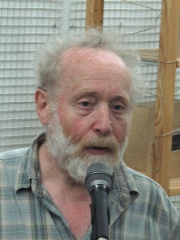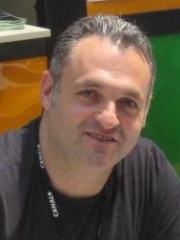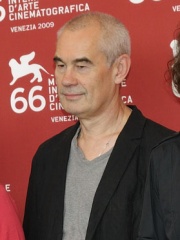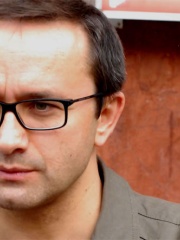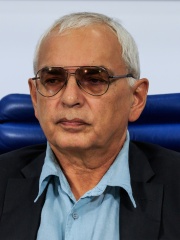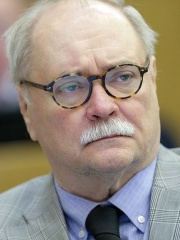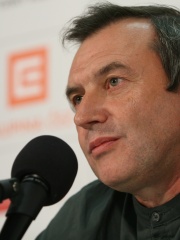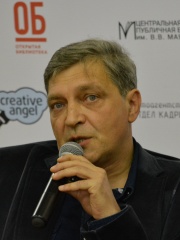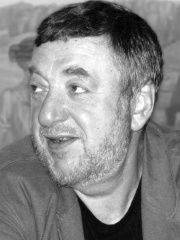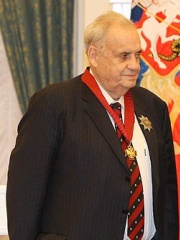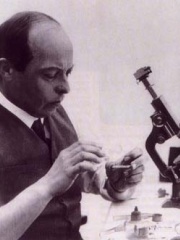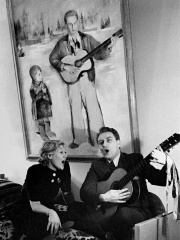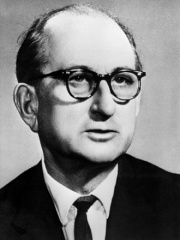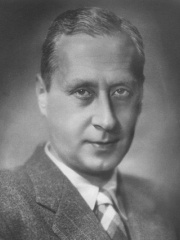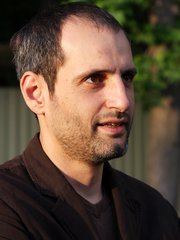

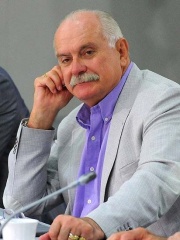
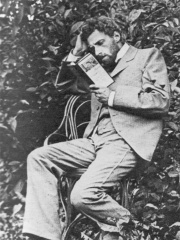

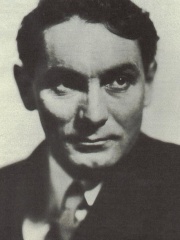

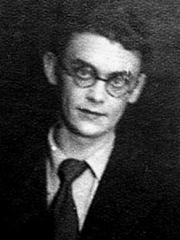
The Most Famous
FILM DIRECTORS from Russia
This page contains a list of the greatest Russian Film Directors. The pantheon dataset contains 2,041 Film Directors, 76 of which were born in Russia. This makes Russia the birth place of the 7th most number of Film Directors behind Germany, and India.
Top 10
The following people are considered by Pantheon to be the top 10 most legendary Russian Film Directors of all time. This list of famous Russian Film Directors is sorted by HPI (Historical Popularity Index), a metric that aggregates information on a biography's online popularity. Visit the rankings page to view the entire list of Russian Film Directors.

1. Andrei Tarkovsky (1932 - 1986)
With an HPI of 78.16, Andrei Tarkovsky is the most famous Russian Film Director. His biography has been translated into 80 different languages on wikipedia.
Andrei Arsenyevich Tarkovsky (Russian: Андрей Арсеньевич Тарковский, pronounced [ɐnˈdrʲej ɐrˈsʲenʲjɪvʲɪtɕ tɐrˈkofskʲɪj] ; 4 April 1932 – 29 December 1986) was a Soviet film director and screenwriter of Russian origin. He is widely considered one of the greatest directors in cinema history. His films explore spiritual and metaphysical themes and are known for their slow pacing and long takes, dreamlike visual imagery and preoccupation with nature and memory. Tarkovsky studied film at the All-Union State Institute of Cinematography under filmmaker Mikhail Romm and subsequently directed his first five features in the Soviet Union: Ivan's Childhood (1962), Andrei Rublev (1966), Solaris (1972), Mirror (1975), and Stalker (1979). After years of creative conflict with state film authorities, he left the country in 1979 and made his final two films—Nostalghia (1983) and The Sacrifice (1986)—abroad. In 1986, he published Sculpting in Time, a book about cinema and art. He died later that year of cancer, a condition possibly caused by the toxic locations used in the filming of Stalker. Tarkovsky was the recipient of numerous accolades throughout his career, including the FIPRESCI prize, the Prize of the Ecumenical Jury and the Grand Prix Spécial du Jury at the Cannes Film Festival in addition to the Golden Lion at the Venice Film Festival for his debut film, Ivan's Childhood as well as the BAFTA Film Award for The Sacrifice. In 1990, he was posthumously awarded the Soviet Union's prestigious Lenin Prize. Three of his films—Andrei Rublev, Mirror, and Stalker—featured in Sight & Sound's 2012 poll of the 100 greatest films of all time.

2. Konstantin Stanislavski (1863 - 1938)
With an HPI of 76.93, Konstantin Stanislavski is the 2nd most famous Russian Film Director. His biography has been translated into 67 different languages.
Konstantin Sergeyevich Stanislavski (; Russian: Константин Сергеевич Станиславский, IPA: [kənstɐnʲˈtʲin sʲɪrˈɡʲejɪvʲɪtɕ stənʲɪˈslafskʲɪj]; né Alekseyev; 17 January [O.S. 5 January] 1863 – 7 August 1938) was a seminal Russian and Soviet theatre practitioner. He was widely recognized as an outstanding character actor, and the many productions that he directed garnered him a reputation as one of the leading theatre directors of his generation. His principal fame and influence, however, rests on his "system" of actor training, preparation, and rehearsal technique. Stanislavski (his stage name) performed and directed as an amateur until the age of 33, when he co-founded the world-famous Moscow Art Theatre (MAT) company with Vladimir Nemirovich-Danchenko, following a legendary 18-hour discussion. Its influential tours of Europe (1906) and the US (1923–24), and its landmark productions of The Seagull (1898) and Hamlet (1911–12), established his reputation and opened new possibilities for the art of the theatre. By means of the MAT, Stanislavski was instrumental in promoting the new Russian drama of his day—principally the work of Anton Chekhov, Maxim Gorky, and Mikhail Bulgakov—to audiences in Moscow and around the world; he also staged acclaimed productions of a wide range of classical Russian and European plays. He collaborated with the director and designer Edward Gordon Craig and was formative in the development of several other major practitioners, including Vsevolod Meyerhold (whom Stanislavski considered his "sole heir in the theatre"), Yevgeny Vakhtangov, and Michael Chekhov. At the MAT's 30th anniversary celebrations in 1928, a massive heart attack on-stage put an end to his acting career (though he waited until the curtain fell before seeking medical assistance). He continued to direct, teach, and write about acting until his death a few weeks before the publication of the first volume of his life's great work, the acting manual An Actor's Work (1938). He was awarded the Order of the Red Banner of Labour and the Order of Lenin and was the first to be granted the title of People's Artist of the USSR. Stanislavski wrote that "there is nothing more tedious than an actor's biography" and that "actors should be banned from talking about themselves". At the request of a US publisher, however, he reluctantly agreed to write his autobiography, My Life in Art (first published in English in 1924 and a revised, Russian-language edition in 1926), though its account of his artistic development is not always accurate. Three English-language biographies have been published: David Magarshack's Stanislavsky: A Life (1950); Jean Benedetti's Stanislavski: His Life and Art (1988, revised and expanded 1999). and Nikolai M Gorchakov's "Stanislavsky Directs" (1954). An out-of-print English translation of Elena Poliakova's 1977 Russian biography of Stanislavski was also published in 1982.

3. Nikita Mikhalkov (b. 1945)
With an HPI of 68.89, Nikita Mikhalkov is the 3rd most famous Russian Film Director. His biography has been translated into 62 different languages.
Nikita Sergeyevich Mikhalkov (Russian: Никита Сергеевич Михалков; born 21 October 1945) is a Russian filmmaker and actor. He made his directorial debut with the Red Western film At Home Among Strangers (1974) after appearing in a series of films, including the romantic comedy Walking the Streets of Moscow (1964), the war drama The Red and the White (1967), the romantic drama A Nest of Gentry (1969) and the adventure drama The Red Tent (1969). His subsequent films include the romantic comedy-drama A Slave of Love (1976), the drama An Unfinished Piece for Mechanical Piano (1977), the romantic drama Five Evenings (1978), the historical drama Siberiade (1979), the romantic comedy Station for Two (1983), the drama Without Witness (1983) and the romantic comedy-drama Dark Eyes (1987). Mikhalkov then directed, co-wrote and appeared in the adventure drama film Close to Eden (1991), for which he received the Golden Lion at the Venice International Film Festival and an Academy Award nomination. Following the Soviet Union's dissolution, Mikhalkov directed, co-wrote and starred in the historical drama Burnt by the Sun (1994), for which he won the Grand Prix at the Cannes Film Festival and the Academy Award for Best Foreign Language Film. He received the "Special Lion" at the Venice Film Festival for his contribution to the cinematography and an Academy Award nomination for the legal drama 12 (2007). Mikhalkov is a three-time laureate of the State Prize of the Russian Federation (1993, 1995, 1999) and Full Cavalier of the Order "For Merit to the Fatherland".

4. Vsevolod Meyerhold (1874 - 1940)
With an HPI of 68.24, Vsevolod Meyerhold is the 4th most famous Russian Film Director. His biography has been translated into 41 different languages.
Vsevolod Emilyevich Meyerhold (Russian: Всеволод Эмильевич Мейерхольд, romanized: Vsévolod Èmíl'evič Mejerchól'd; born German: Karl Kasimir Theodor Meyerhold; 9 February [O.S. 28 January] 1874 – 2 February 1940) was a Russian and Soviet theatre director, actor and theatrical producer. His provocative experiments dealing with physical being and symbolism in an unconventional theatre setting made him one of the seminal forces in modern international theatre. During the Great Purge, Meyerhold was arrested in June 1939. He was tortured, his wife was murdered, and he was executed on 2 February 1940.
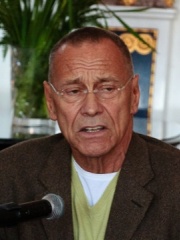
5. Andrei Konchalovsky (b. 1937)
With an HPI of 68.01, Andrei Konchalovsky is the 5th most famous Russian Film Director. His biography has been translated into 54 different languages.
Andrei Sergeyevich Konchalovsky (Russian: Андрей Сергеевич Кончаловский; né Mikhalkov; born 20 August 1937) is a Russian film and theatre director, screenwriter, and producer. His filmmaking career spans over 60 years in Soviet, Hollywood, and contemporary Russian cinema. Early in his career, he was a screenwriting collaborator of Andrei Tarkovsky. His film credits include Uncle Vanya (1970), Siberiade (1979), House of Fools (2002), The Postman's White Nights (2014), Paradise (2016), and Dear Comrades! (2020). During the 1980's, he resided in the United States, where he directed films such as Maria's Lovers (1984), Runaway Train (1985), Shy People (1987), and Tango & Cash (1989). He also directed the 1997 miniseries adaptation of the ancient Greek narrative The Odyssey. His films have won numerous accolades, including the Cannes Grand Prix Spécial du Jury, a FIPRESCI Award, two Silver Lions, three Golden Eagle Awards, and a Primetime Emmy Award. He is the laureate of several civil honours in Russia and abroad, including the Order "For Merit to the Fatherland", a National Order of the Legion of Honour, a French Officer of the Order of Arts and Letters, a Cavalier of the Order of Merit of the Italian Republic and a People's Artist of the RSFSR. Konchalovsky is a member of the Mikhalkov family. His father is Sergey Mikhalkov, the lyricist of the Soviet and Russian national anthems, and his brother is filmmaker Nikita Mikhalkov.

6. Lev Kuleshov (1899 - 1970)
With an HPI of 67.39, Lev Kuleshov is the 6th most famous Russian Film Director. His biography has been translated into 36 different languages.
Lev Vladimirovich Kuleshov (Russian: Лев Владимирович Кулешов; 13 January [O.S. 1 January] 1899 – 29 March 1970) was a Russian and Soviet filmmaker and film theorist, one of the founders of the world's first film school, the Moscow Film School. He was given the title People's Artist of the RSFSR in 1969. He was intimately involved in development of the style of film making known as Soviet montage, especially its psychological underpinning, including the use of editing and the cut to influence the emotions of audience, a principle known as the Kuleshov effect. He also developed the theory of creative geography, which is the use of the action around a cut to connect otherwise disparate settings into a cohesive narrative.

7. Vsevolod Pudovkin (1893 - 1953)
With an HPI of 67.08, Vsevolod Pudovkin is the 7th most famous Russian Film Director. His biography has been translated into 42 different languages.
Vsevolod Illarionovich Pudovkin (Russian: Всеволод Илларионович Пудовкин, IPA: [ˈfsʲevələt ɪl(ː)ərʲɪˈonəvʲɪtɕ pʊˈdofkʲɪn]; 28 February 1893 – 30 June 1953) was a Soviet film director, screenwriter and actor who developed influential theories of montage. Pudovkin's masterpieces are often contrasted with those of his contemporary Sergei Eisenstein; Eisenstein utilized montage to glorify the power of the masses, while Pudovkin preferred to concentrate on the courage and resilience of individuals. He was granted the title of People's Artist of the USSR in 1948.

8. Elem Klimov (1933 - 2003)
With an HPI of 65.12, Elem Klimov is the 8th most famous Russian Film Director. His biography has been translated into 31 different languages.
Elem Germanovich Klimov (Russian: Элем Германович Климов; 9 July 1933 – 26 October 2003) was a Soviet and Russian filmmaker. He studied at the Gerasimov Institute of Cinematography, and was married to film director Larisa Shepitko. Klimov is best known for his final film, Come and See (Иди и смотри), which follows a teenage boy in German-occupied Byelorussia during World War Two and which received universal acclaim. His work also includes black comedies, children's movies, and period dramas.

9. Leonid Gaidai (1923 - 1993)
With an HPI of 65.02, Leonid Gaidai is the 9th most famous Russian Film Director. His biography has been translated into 57 different languages.
Leonid Iovich Gaidai (30 January 1923 – 19 November 1993) was a Soviet and Russian comedy film director, screenwriter and actor who enjoyed immense popularity and broad public recognition in the former Soviet Union. His films broke theatre attendance records and were some of the top-selling DVDs in Russia. He has been described as "the king of Soviet comedy".
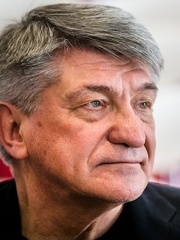
10. Alexander Sokurov (b. 1951)
With an HPI of 63.79, Alexander Sokurov is the 10th most famous Russian Film Director. His biography has been translated into 40 different languages.
Alexander Nikolayevich Sokurov, PAR (Russian: Александр Николаевич Сокуров; born 14 June 1951) is a Russian filmmaker. His most significant works include a feature film, Russian Ark (2002), filmed in a single unedited shot, and Faust (2011), which was honoured with the Golden Lion, the highest prize for the best film at the Venice Film Festival.
People
Pantheon has 76 people classified as Russian film directors born between 1861 and 1991. Of these 76, 23 (30.26%) of them are still alive today. The most famous living Russian film directors include Nikita Mikhalkov, Andrei Konchalovsky, and Alexander Sokurov. The most famous deceased Russian film directors include Andrei Tarkovsky, Konstantin Stanislavski, and Vsevolod Meyerhold. As of April 2024, 2 new Russian film directors have been added to Pantheon including Ilya Naishuller, and Alexei Popogrebski.
Living Russian Film Directors
Go to all RankingsNikita Mikhalkov
1945 - Present
HPI: 68.89
Andrei Konchalovsky
1937 - Present
HPI: 68.01
Alexander Sokurov
1951 - Present
HPI: 63.79
Yuri Norstein
1941 - Present
HPI: 60.12
Genndy Tartakovsky
1970 - Present
HPI: 60.11
Sergei Bodrov
1948 - Present
HPI: 59.79
Andrey Zvyagintsev
1964 - Present
HPI: 59.52
Karen Shakhnazarov
1952 - Present
HPI: 56.70
Vladimir Bortko
1946 - Present
HPI: 56.01
Alexei Uchitel
1951 - Present
HPI: 55.46
Alexander Nevzorov
1958 - Present
HPI: 55.35
Pavel Lungin
1949 - Present
HPI: 54.77
Deceased Russian Film Directors
Go to all RankingsAndrei Tarkovsky
1932 - 1986
HPI: 78.16
Konstantin Stanislavski
1863 - 1938
HPI: 76.93
Vsevolod Meyerhold
1874 - 1940
HPI: 68.24
Lev Kuleshov
1899 - 1970
HPI: 67.39
Vsevolod Pudovkin
1893 - 1953
HPI: 67.08
Elem Klimov
1933 - 2003
HPI: 65.12
Leonid Gaidai
1923 - 1993
HPI: 65.02
Eldar Ryazanov
1927 - 2015
HPI: 63.75
Ladislas Starevich
1882 - 1965
HPI: 63.33
Grigori Aleksandrov
1903 - 1983
HPI: 61.30
Mikhail Romm
1901 - 1971
HPI: 61.26
Sergei Yutkevich
1904 - 1985
HPI: 60.66
Newly Added Russian Film Directors (2025)
Go to all RankingsOverlapping Lives
Which Film Directors were alive at the same time? This visualization shows the lifespans of the 25 most globally memorable Film Directors since 1700.

